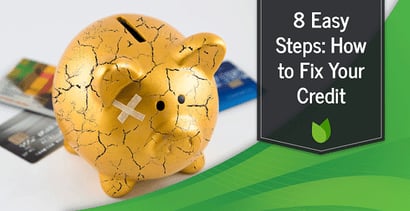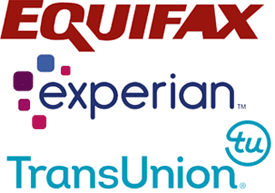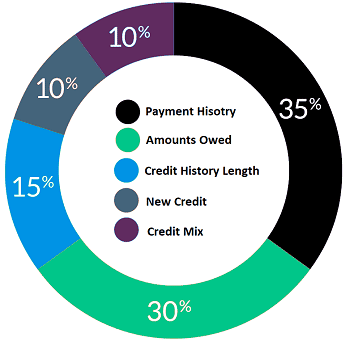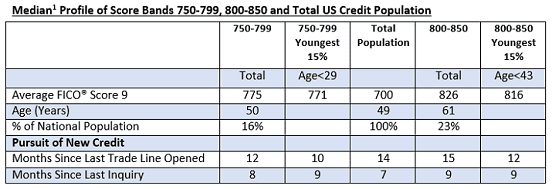

Perhaps you’ve made some financial missteps in the past and your credit score shows it, but you’re ready to turn things around and get back on firm financial footing. Knowing how to fix your credit score is an essential part of regaining financial health. While the range of possible credit scores can vary based on the model used to calculate your score, the two most popular models, FICO and VantageScore, use a scale of 300 to 850, with 850 being the highest (best) you can score. For those struggling with poor credit, the very idea of reaching a score of 850 can seem downright ludicrous — but it’s an achievement reached by nearly 3 million Americans.
Of course, you don’t have to be gunning for the top spot to want to fix your credit score. Simply wanting to lower your credit risk and improve your available credit options can be enough motivation to enact a credit repair plan. Then there’s the cost of bad credit; the lower your score, the higher your interest rates, and those fees can add up remarkably fast.
The exact actions you need to take to fix your credit score will largely depend on your individual credit situation. That said, every consumer’s credit score is calculated using the same factors, so some of the steps will be universal. Let’s take a look at some easy steps you can take to repair or improve your existing credit score. Some of these steps involve patience and diligence on your part and others involve bringing in professional assistance.
1. Check Your 3 Credit Reports
No matter how you got into your current credit predicament, the first step to fixing it will always be to do a thorough check of your credit reports — all three of them. That’s right, you have three, one from each major consumer credit bureau: Equifax, Experian, and TransUnion.
Thanks to the Fair Credit Reporting Act (FCRA), you’re entitled to access the information collected by the credit bureaus, and can do so for free once a year through AnnualCreditReport.com. Contrary to the common misconception, checking your own credit report or score won’t impact your score.

It’s important to check all three of your credit reports, as the information on each report can differ. That’s because credit bureaus generally don’t actively seek out information from your creditors. Instead, they typically rely on your creditors reporting information about your credit use to them — as most do; however, not every creditor will report to all three bureaus, so information can vary between reports.
Since your credit score is calculated using the information from your credit reports, your score can actually be different depending on which credit report was used. Furthermore, when creditors pull your credit report, they can pull any of the three reports — or all three reports — to assess your credit risk, and will either average your credit scores or take the lowest score if variations occur.
2. Remove Errors & Unsubstantiated Accounts
Once you have all of your credit reports in hand, you should carefully inspect them for any inaccurate, out-dated, or unsubstantiated information and accounts. The credit bureaus aren’t required to verify information before it is published on your report, so mistakes can occur.
That said, while the bureaus aren’t required to verify information beforehand, they are required to address mistakes or other account disputes when brought to their attention — and to do so in a timely manner. You can file disputes directly with the credit bureaus yourself, or, if you prefer the hands-free option, hire a reputable credit repair company to address the problems on your behalf. Our top-rated picks include a variety of plan options and price levels.
- Since 2004, Lexington Law Firm clients saw over 81 million items removed from their credit reports
- Get started today with a free online credit report consultation
- Cancel anytime
- See official site, terms, and details.
| Better Business Bureau | In Business Since | Monthly Cost | Reputation Score |
|---|---|---|---|
| See BBB Listing | 2004 | $99.95 | 8/10 |
- Best-in-class support
- In business since 1989
- Rapid 35-day dispute cycle, tailored to your situation
- 90-day 100% money-back guarantee
- Low $79 cost to get started, cancel or pause membership anytime
- See official site, terms, and details.
| Better Business Bureau | In Business Since | Monthly Cost | Reputation Score |
|---|---|---|---|
| A+ | 1989 | $79 | 9.5/10 |
- Free online consultation
- CreditRepair.com members saw over 8.6 million removals on their credit reports since 2012
- Free access to your credit report summary
- Three-step plan for checking, challenging and changing your credit report
- Online tools to help clients track results
- See official site, terms, and details.
| Better Business Bureau | In Business Since | Monthly Cost | Reputation Score |
|---|---|---|---|
| See BBB Listing | 2012 | $69.95+ | 8/10 |
+See More Credit Repair Companies
Specific mistakes to look for on your reports include simple issues, such as misspelled names, to more complex problems, like the results of identity theft. For example, you’ll need to ensure that your report only shows accounts that actually belong to you — and that you were the one who opened them — as well as looking into administrative issues like verifying that your open and closed accounts have the correct status.
You should also be aware of (and dispute) any outdated information or accounts, especially those that are negatively impacting your credit. Thanks again to the FCRA, negative marks on your credit report have an expiration date. Hard credit inquiries, for instance, should drop off your report in no more than 24 months, while missed payments and delinquent accounts can hang around for seven years. Bankruptcy discharges are the worst, lasting up to 10 years.
3. Pay Down Balances
Of all the ways you can improve your credit score, perhaps the one with the quickest results is to pay down your existing balances, particularly credit card balances. This can be especially effective if you tend to carry a large balance from month to month. Your current debts and credit utilization account for 30% of your credit score, so the amount of debt you carry on your cards can have a huge impact on your score.
In general, a good rule of thumb is to keep your utilization rate below 30% on each credit card. To calculate your current utilization rate, simply divide your current balance by your total credit limit. For example, if Jose has a credit card with a balance of $1,000, and a total credit limit of $5,000, Jose’s utilization rate for that card is: $1,000 / $5,000 = 0.20, or 20%.

Additionally, try to make your credit card payments before the end of your statement period (and always, always, always before your bill is due). The balance you have at the time your statement drops is the balance that will be reported to the credit bureaus, so paying early can net you a few extra credit score points.
4. Decrease Your Interest Rates
If you’re stuck dealing with bad credit, of course, telling you to pay down your debt is likely quite redundant. Many people would happily pay down their debt if they could — they simply can’t afford to do so. One way to make repaying your debt more affordable is to lower your interest rates, thus decreasing your monthly payment as well as the amount of time it takes to pay off your debt.
While this can mean negotiating with creditors directly to secure a lower rate and/or negotiate a payment plan, you may be able to consolidate at a lower rate, instead. This involves taking out a personal loan with a lower APR, then using the loan to pay off your high-interest credit card debt. Consolidation will also turn multiple credit card bills into a single, easy loan payment. Our favorite loan providers offer amounts from $500 up to $35,000.
- Short-term loans up to $5,000
- Online marketplace of lenders
- Funds available in as few as 24 hours
- Simple online form takes less than 5 minutes
- Trusted by more than 2 million customers
- See official site, terms, and details.
| Loan Amount | Interest Rate | Loan Term | Loan Example |
|---|---|---|---|
| Up to $5,000 | Varies | Varies | See representative example |
- Personal loans of $2,000 to $35,000
- Compare rates in 2 minutes without affecting your credit
- Best for low origination fees for bad credit
- 550 minimum credit score required
- Powered by Credible
- See official site, terms, and details.
| Loan Amount | Interest Rate | Loan Term | Loan Example |
|---|---|---|---|
| $2,000 to $35,000 | 9.95% - 35.99% | 12 to 60 Months | See representative example |
- Personal loans starting at $1,000
- Find loans you prequalify for, complete your application, and close your loan
- Loans for 300+ FICO Scores
- Checking rates doesn't impact your credit score
- Powered by Credible
- See official site, terms, and details.
| Loan Amount | Interest Rate | Loan Term | Loan Example |
|---|---|---|---|
| $1,000 to $50,000 | 6.40% - 35.99% | 3 or 5 Years | See representative example |
It can be tempting to take out as long a loan as possible — many lenders offer up to 60 months — to obtain the lowest monthly payments, but this may not always be the best strategy. The longer you take to pay off your debt, the more total interest you’ll end up paying overall.
On the other hand, if you need to extend your loan terms to ensure you can afford the monthly payment, you should do what’s necessary. Missing payments can undo any credit score benefits obtained from paying down your balances, or even make your score worse than it was when you started.
5. Communicate with Your Creditors
People in debt may sometimes feel their creditors are out to get them, that card issuers and lenders are hoping consumers fall behind and become unable to pay off their debts. News flash: Creditors don’t want you to default on your debt — they want to get paid.
Many creditors are typically more than happy to discuss all the options for getting their money, and are often willing to negotiate lowered rates or other assorted repayment plans to help you get back on track. Indeed, the biggest problem isn’t that your creditors don’t want to help, but, rather, that many consumers don’t contact them until it’s too late.
The best time to talk to your creditors isn’t when you’re already six months behind in your payments — it’s before you’ve fallen behind at all. If your account is in good standing but you’re going through a life event that will make it hard for you to make your next payment on time (or at all), you should contact your creditor right away to work it out.
That’s not to say that you shouldn’t contact your creditor if you’ve already missed a payment (or three) — just don’t put it off for too long. The sooner you open a dialogue with your creditor, the more options you’ll have available and the easier it will be to set things to rights.
6. Automate Your Payments
At the end of the day, of course, the easiest way to fix the credit damage wrought by missed payments, is to avoid having missed payments in the first place. While this is more challenging when the budget is tight, it isn’t always impossible. And since your payment history is 35% of your credit score, it can be worth any trouble.
For instance, communicating with your creditors before you miss a payment can give you the breathing room to get to the next paycheck without worrying about a delinquent payment.

Those who are more likely to miss a debt payment due to the lack of a calendar rather than the lack of funds can take advantage of technology to stay on track. Specifically, setting up automatic bill payments from your checking or savings account can ensure you’ll never pay late.
You can even set your payments to go through early, thus enabling you to pay down your reported balance before your statement. You may also consider setting up automatic payments to make multiple payments during each billing cycle. Not only can this reduce your reported balance but, thanks to the way interest works, it can also decrease the amount of interest you pay by lowering your average daily balance.
7. Periodically Use Old Cards
Many consumers who have battled their way through bad credit are inclined to throw away their old credit cards as they pay them off, or, worse, swear off credit entirely. Both are bad ideas. You often need credit to get credit, and unless you plan on paying for your next car or home with cash — you’re going to need credit.
In particular, you’re going to want old credit, because that’s the kind creditors like best. In fact, a full 15% of your credit score is based on the age of your credit accounts, including the age of the oldest account and the average age of all of your credit accounts. The older your accounts, the less of a credit risk you appear to future creditors, who like to see that you can handle debt over the long term.
This means keeping old cards open — and using them periodically to ensure they remain open. Issuers will often close old credit accounts that have gone unused for more than 12 months.
The main exception to this is if your credit cards carry annual fees. In this case, you’ll have to consider the cost of paying the annual fee against the potential cost to your credit score of closing the account. The level of impact to your score will depend on the age of the account, and the age of your other accounts. If you intend to apply for a major loan in the near future, such as taking on a new mortgage, you may want to avoid closing old accounts.
8. Apply for New Accounts Wisely
While it’s important to keep your older accounts open, it’s just as important to be careful about how and when you open new accounts. Not only does each new account decrease your average account age — which contributes to 15% of your credit score — but every application for a new credit account will be taken into consideration, as well. Indeed, new accounts make up a full 10% of your score calculation.

Before applying for new credit, carefully consider if you’ll be applying for additional new credit in the near future, and whether you need the credit at all. A characteristic shared by the 3 million Americans with perfect credit is the tendency to open new credit sparingly, and the typical super-prime consumer goes an average of nine months between new inquiries.
Of course, as you work on fixing your credit, the credit score dings from opening new accounts will become less intense. As you approach the national average of a 700 FICO score and the “good credit” category, you’ll be better able to handle both the credit score impacts of new credit — as well as the financial responsibility it represents.
Advertiser Disclosure
BadCredit.org is a free online resource that offers valuable content and comparison services to users. To keep this resource 100% free for users, we receive advertising compensation from the financial products listed on this page. Along with key review factors, this compensation may impact how and where products appear on the page (including, for example, the order in which they appear). BadCredit.org does not include listings for all financial products.
Our Editorial Review Policy
Our site is committed to publishing independent, accurate content guided by strict editorial guidelines. Before articles and reviews are published on our site, they undergo a thorough review process performed by a team of independent editors and subject-matter experts to ensure the content’s accuracy, timeliness, and impartiality. Our editorial team is separate and independent of our site’s advertisers, and the opinions they express on our site are their own. To read more about our team members and their editorial backgrounds, please visit our site’s About page.










